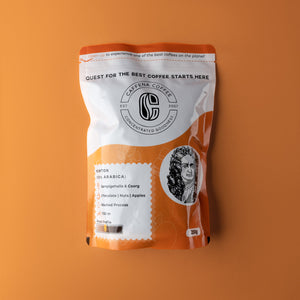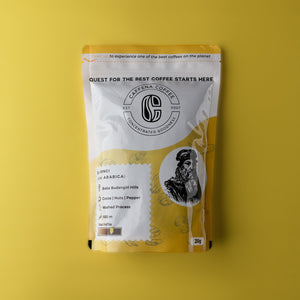Introduction to Arabica
Coffee, also known as the drink that seems to kickstart the world every morning. From a creamy latte or punch in the face espresso, it plays a key role in our daily lives. And in this integral part, the term “Arabica” for many has become a synonymous cornerstone of specialty coffee or the third wave of coffee.
Let’s dive in to find out what makes this specific type of coffee so popular that it in fact dominates with a 60% share of all coffee consumed in the world.
Here’s what to expect -
The History of Arabica.
- An African Tribe Snack
- A Monopolistic Commodity
- Globalization
Modern Day Arabica
- The Specialty Coffee Wave
- Arabica and its nuances
The Future of Arabica.
- A Concerning Future
- Climate Change
Conclusion
The History of Arabica
An African Tribe Snack
Its origins date back to approximately 1,000 BC withinside the highlands of the Kingdom of Kefa, which is present-day Ethiopia. In Kefa, the Oromo tribe consumed the bean by beating it and combining it with fats to make spheres (roughly the size of ping-pong balls). These spheres served the identical purpose of a modern-day espresso, as a stimulant.

The plant species Coffea Arabica was given its name in the seventh century whilst the bean crossed the Red Sea from Ethiopia to present-day Yemen and decrease Arabia, subsequently the name "arabica."
A Monopolistic Commodity
The first written file of a coffee drink crafted from roasted coffee beans comes from Arab scholars, who wrote that it was beneficial in prolonging their operating hours. The Arab innovation in Yemen of creating a brew from roasted beans unfolded first amongst the Egyptians and Turks, and later on, discovered its manner across the world. One very peculiar but important factor for coffee’s popularity was the fact that the Muslims of the region could not drink wine, this allowed the beverage to grow exponentially popular in a short span of time.
This meant the creation of local coffee houses and breweries which soon became places of discussion and ideas. People came together at such places, sharing their thoughts and spreading their word. These coffee houses even became places of trade where travellers from all across the world were served coffee. Coffee had now become an integral part of Arabian culture.

This empirically brought prosperity to the land in the form of trade which Yemen cunningly maintained a monopoly over. They achieved this by banning the export of any green beans from Yemen, allowing only roasted beans to be shipped for consumption as they could not be used to grow the coffee plant.
Globalization
The globalization of coffee was one of the early instances of globalized trade and its benefits. The Yemenese Monopoly was flourishing in stride when a troubled Sufi saint from the cradle of Chandragiri Hills, India visited the country on Hajj.
After he was offered an elusive dark-colored tonic that almost magically cured his sea sickness. Baba Budan was determined to take it to his homeland. And after multiple attempts to get around the system and calling a few favors he managed to smuggle some green fertile beans in his long beard!
He returned to India and as this coffee was planted, it soon caught the eye of the British overlords. They saw huge trade potential and started shipping Indian coffee to the UK and even started mass production in other colonies.

This is how the coffee craze actually started in England just like in Yemen. And by the 1650s coffee houses became the new rage and places where influential men would come and share ideas and discuss policy so much so that cafes started to be called Penny Universities. Part of the reason was their novelty. But with this rise came a backlash: In a hilarious pamphlet published in 1674, a group of women came out against the newfangled, abominable, heathenish liquor called coffee.” (More on The Petition of Women Against Coffee soon!)
The baptism of coffee by the Pope also helped in fueling the popularity of the beverage. Soon coffee became the beverage of choice in the western hemisphere with the East fueling and supplying the rage. Thanks to the plantations set by the Dutch specifically in Indonesia.
Modern Day Arabica
The Specialty Coffee Wave
The third wave of coffee is characterized by coffee lovers interested in the character of the coffee itself. Sometimes this movement is more of a reaction against bad coffee and the way bad coffee has been promoted. Not that marketing and social are not important in third-wave growth, but they are not the driving force. Look at it this way: In the first wave, the consumer led the way. It was all about availability to the masses on a national scale. With the second wave, the coffee was better, but marketing the experience was the driving force. With the third wave, marketing takes the back seat, and the product takes centre stage.
With a new emphasis on transparency within the coffee industry, consumers can trace the heritage of their favourite coffee to the very farm from which it was harvested. The soil, altitude, and method of processing become important factors to the discerning pallet.
The majority of roasters and coffee shops associated with the third wave are small businesses, independently owned and operated. Roasters and coffee shops that roast beans in-house represent entrepreneurs who love great coffee and have created a business to share that coffee with their communities.
Arabica and its nuances
Arabica coffee is usually grown at an altitude of around 2800m above sea level with a moderate climate that is neither too cool nor too hot. If the temperature is too cold, the plant may freeze and if the temperature is too hot, the leaves will wither away and the plant may die. This means tropical areas like Brazil, Indonesia, and Columbia are the main cultivating grounds of Arabica. This is because they offer a balanced warm temperature across the calendar. These plants take about two-three years to blossom into fruit-bearing flowers.

Arabica coffee beans are considered to have a much deeper and layered flavour profile allowing them to be a go-to choice for black coffee fanatics. This is different when compared to its Robusta counterpart which has a relatively harsher flavour profile.
This is the reason why Arabica coffee beans have higher demand in the market than Robusta coffee beans. There are also blended options that offer proportionate blends of both. You may not see this often in the world of speciality coffee but they have a much larger audience that appreciates the punch of robusta blended into Arabica’s complexities.
There are many variants of Arabica but the most common ones in today’s market are Typica and Bourbon. These are also considered to be the first ones to be taken out of Ethiopia and used in widespread cultivation. Typically, it is a name that justifies its nature as it is one of the most cropped and circulated Arabica types in the world. It is well adapted to cold weather conditions, and high altitudes and produces a deep flavour profile coffee with a rich aroma. The Typica variety is also a bit harder to produce due to its susceptibility to being infected with coffee rust. It is usually a low-yielding variety, which also plays a role in its popularity and price. Some examples of Typica coffee are the Jamaican Mountain Blue and the Hawaiian Kona coffee. Bourbon is also one of the oldest varieties of Arabica and its name comes from Bourbon Island where it was first cultivated. The bourbon variant also has many sub-variants which are the result of genetic mutations over time. These are called Red Bourbon, Yellow Bourbon, and Orange Bourbon.
Arabica coffee, when dry processed, gives out a much sweeter and fruitier taste. It retains its natural cherry state. The washing method gives out a flavour profile that is much cleaner and gives out the flavour of the beans themselves. Honey processing of Arabica lies somewhat in the middle of wet processing and dry processing. Different types of roasts give out different results when it comes to Arabica beans. A darker roast will give out a stronger flavour of the beans mixed with the roast and will have overall less acidity. A lighter roast will retain more of the fruity flavour profile and with more acidity. Dark roasted Arabica has a stronger smoky flavour pallet.

A big problem with Arabica cherries, from which the beans are produced is that they ripen with different timelines. This means that they have to be handpicked most often for the highest quality beans. Another method is to collect all the beans at once by vigorously shaking the tree and then sorting the beans on the basis of their maturity. A tree or shrub of Arabica usually produces anywhere from 0.5g to 1.5kg of coffee which shall be considered saleable. Ripe cherries are great but if there is an overpopulation of the coffee flower on the tree, then the crops might get damaged. Such plantations are taken care of to the extreme to preserve the quality of production.
The Future of Arabica
The Future of Arabica is a topic that seems rather concerning. This is due to the fact that soon Arabica may not exist due to the changes that are happening in our world. As explained above in the article, Arabica is the type of coffee that is sensitive to many factors which affect its growth and yield. These factors are temperature, altitude, soil structure, etc. All these factors are now at risk. The 98.8% genetic similarity found between Arabica strains by the World Coffee Research Organization is one of the reasons why a single problem that may disrupt coffee production in plantations may also disrupt all varieties of Arabica coffee produced.
The problems which come to mind right away would be climate change and disease. The disease is not something new that coffee production has faced. Coffee rust is a widespread disease that can decimate entire crop plantations if not treated. Climate change also plays a role in the endangerment of Arabica production as it is vulnerable to temperature changes. Let us go deeper and study these factors how they affect Arabica and if there is something that we can do about it.
Climate Change
Climate Change is something that we have all heard of especially in today’s world. The growing economies focus on maximizing production. The direct repercussion is seen in the environment and this repercussion has a heavy impact on how Arabica is grown. Rising temperatures due to global warming cause areas to become unsuitable for coffee production. Arabica coffee plants need temperatures of around 18 to21 degrees Celsius, a specific amount of rain and a three-month dry season for the flowers to bloom. They would also need to be at an elevation of 1000 to 2000 meters above sea level. If we add all these up, we see that the tropical regions would be the perfect place for coffee production, and in fact, they are. Brazil, the biggest coffee producer is also a part of the Earth’s tropical belt. Followed by Vietnam, Indonesia, Columbia, and Ethiopia.
One of the biggest factors that affect coffee production has to be the warming of the environment. This has caused the regions of coffee plantations to shift resulting in the areas which were once perfect, being unproductive. It is said that the area for coffee production is predicted to fall by 50% by the year 2050 as per the Inter American Development Bank Organization. This huge decline, if it continues would not be able to cater to a world with an ever-growing demand for coffee, especially Arabica. Climate change has caused the earth to get warmer by 1 degree Celsius and this number is estimated to climb to 3 degrees Celsius by the year 2100. This not only results in the non-usability of the land but also a very low yield in coffee production. This, in the end, will make coffee not the most luring industry for low-scale farmers. Approximately one-third of all coffee which is sold worldwide is sourced from small-scale farmers as per the Food and Agriculture Organisation.
The second effect of climate change on coffee production would be large-scale unemployment. As big corporations pull out of regions of high coffee production. Many countries focus on coffee as their main trade commodity. This in return balances their economies and creates employment on a large scale. This also helps in stabilizing and bettering the lifestyle of workers in third-world countries. Even if we look at the coffee farms, we find that the number of blue-collar workers is much more than white-collar workers. These workers in Arabica production include hand pickers, washers, roasters, etc.
This shifting of regions will also open doors to new regions for coffee production but climate change will always place a sense of uncertainty as to which areas will be good for cultivation and harvest and for how long. There is also the fear of diseases that can be spread through coffee plantations and destroy entire farms in terms of yield and quality.
ConclusionArabica has been through quite a long journey through trade routes, wars, and diseases that almost wiped it out to finally become what we like to refer to as the golden child of speciality coffee. And as of today, it lies at the heart of the coffee industry for connoisseurs and amateurs alike.
With changing climate patterns it is almost certain that the effect on the coffee industry would be massive and almost half of all coffee-producing regions would be gone. This would wipe out the industry and the livelihood of millions in one form or another. (If you would like to explore the whole story of your cup of coffee here's a really interesting book by best-selling author AJ Jacobs, Thanks a Thousand).
Congratulations! You made it to the end of this really detailed article, we hope you enjoyed the journey. Do you think we missed out on something? Or would you like to learn more about any particular topic? Drop us a message and we would love to have a chat or send some more content your way!
Stay up to date with other such articles by signing up to our Stay Caffena-ted Loyalty program here. See you next time!





